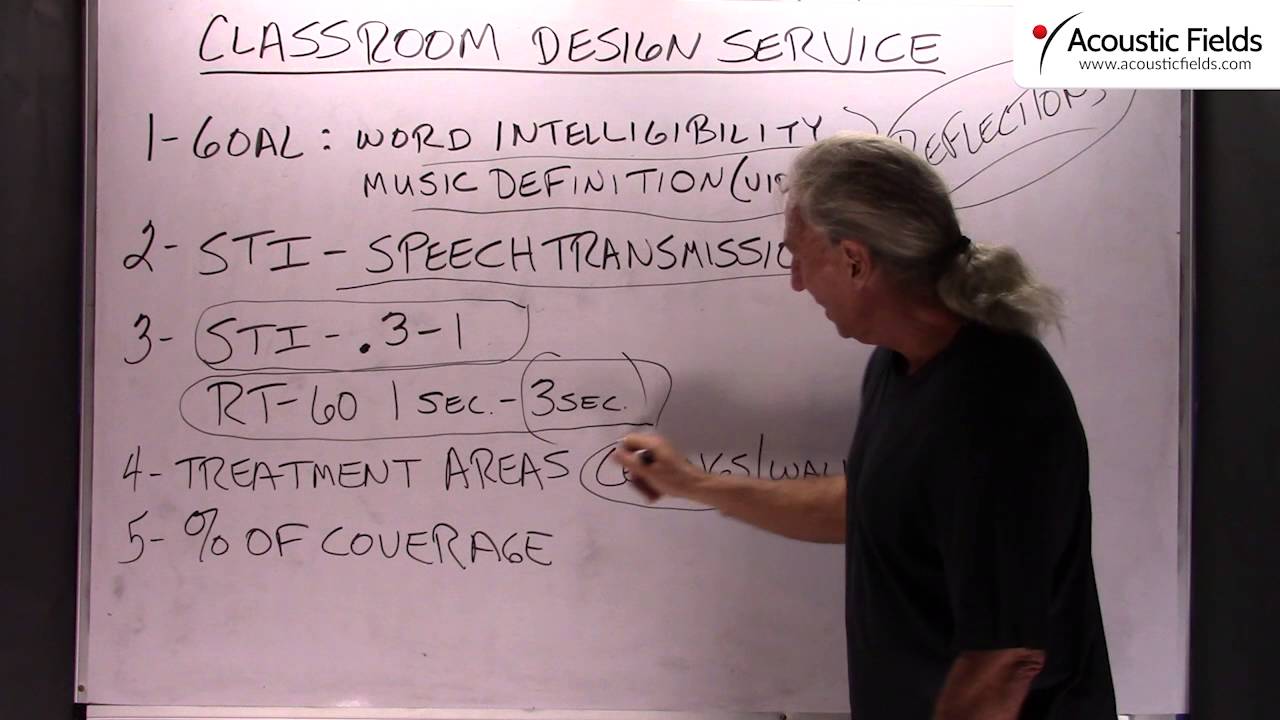Today we’re going to talk about our classroom design service. We get a lot of work with classrooms, we do a lot of work with churches.
And what is the goal in a classroom? Obviously, you have to hear the spoken word. Because the teacher’s up in front of the class, the students are in the audience, you have to have word intelligibility. That’s the key. We also have to have music definition. I want to say music intelligibility but there’s really no such thing but I think you get the idea.
So we have music, we have video being displayed in the classroom, we have word intelligibility, we have all kinds of frequencies that we have to deal with. So but the main thing in classrooms that we’re dealing with acoustically is reflections. That’s the key. So you have to keep that in mind, reflections off all the surfaces.
For word intelligibility we do have an index, it’s called the STI index that we use and it has a rating of .3 to .1. So that’s the goal you’re trying to shoot for and that’s really just controlling the RT-60 or the amount of reflection times that you have in the room. So both of these calculations must be used interchangeably. RT-60 calculations in most rooms run around the 3 second range and we try to get it down into the one second range and that compliments the STI index nicely, too.
So the big thing in classrooms is surface area. Since we’re dealing with reflections off of surface areas in the room, if the teacher’s up here and she’s speaking then we have reflections off all the surfaces; floor ceiling and all that and then we have the kids out here in the classroom sitting and they get smothered by all those reflections and sometimes they hear it and most times they can’t.
So the ceiling and the walls are areas that we have to be focused on for treatment. You’ve got to be able to give up some of those surface areas and you have to be able to treat. The ceiling is the most popular, drop ceilings are the most popular, we have a new product coming out in the next couple of weeks about ceilings and you’ll get a chance to see that. It’s basically our 2 inch foam attached to existing suspended ceiling tiles, so you get an idea of how we can increase the horse power in the treatment are and more particularly for classrooms, the ceiling.
And that leaves the walls free hopefully depending again on size, volume and what’s going on inside the room itself. So it’s always a tug of war between what you require to get your indexes correctly and manage your reflections versus the amount of coverage that somebody wants to put in a classroom.
So start with the ceiling first, we can do a lot of acoustical control and management using the ceiling and then if you need a little bit more, we always go to the rear wall. Because the rear wall is a big contributor to not being able to hear and have everything defined correctly.
So classroom design service, we consider all the variables and we also design our own technologies to solve the acoustical issues that you’re faced with.
—
This is an unedited transcript from our video series from Acoustic Fields. There will be some errors in grammar and sentence structure that occur during this translation process.
For complete understanding and comprehension, please view the video which is included in this text. For any additional information regarding this topic or others relating to room acoustics, please contact us directly at:
P: 520 – 392 – 9486







